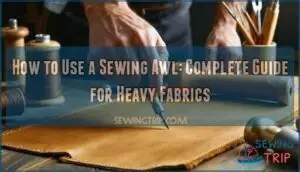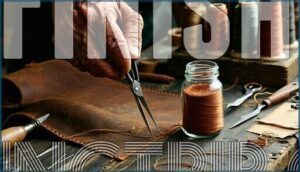This site is supported by our readers. We may earn a commission, at no cost to you, if you purchase through links.

You’ll push the needle through your material, pull the thread completely through, then create a secure loop by passing the thread through itself on the return stitch. The key lies in maintaining consistent tension while keeping the needle’s groove facing downward to prevent skipped stitches.
With proper technique, your awl becomes an indispensable companion for sailmaking, upholstery work, and leather crafting projects that demand strength over speed.
Table Of Contents
Key Takeaways
- Master the lock-stitch technique – Push the needle through, pull the thread completely through, then pass the loose thread through the loop that forms to create secure, durable seams that won’t come apart under stress.
- Maintain consistent thread tension and needle position – Keep steady pressure with your thumb on the handle thread and ensure the needle’s groove faces downward to prevent skipped stitches and tangled thread.
- Match your needle size and thread weight to material thickness – Use larger needles with heavier waxed thread for thick leather, smaller needles for lighter fabrics, and always pre-mark your stitch lines for accuracy.
- Finish properly for lasting repairs – Create a final lock-stitch through the last hole, tie secure double knots, trim excess thread close to the surface, and apply a small amount of leather cement for extra reinforcement.
Parts of an Awl
Think of a sewing awl like your trusty Swiss Army knife for heavy-duty stitching—it’s got everything you need packed into one clever tool. The handle holds your thread bobbin and houses the chuck mechanism that grips interchangeable needles.
You’ll find straight needles for thick materials and curved ones for tight spots, while the hollow handle feeds waxed thread smoothly to your needle’s eye.
Set Up Your Stitch
Picture this: your awl’s threaded and you’re ready to go, but mess up here and you’ll spend the next ten minutes untangling thread. Start by pushing your needle through from the back—that’s your entry point.
Here’s the thing about materials: thick leather calls for a completely different needle than canvas does, so don’t just grab whatever’s handy.
- Mark your holes first using a ruler or awl guide for straight, even spacing
- Create the "grabber loop" by pulling the awl back slightly after penetrating the material
- Balance thread tension carefully—too tight binds the material, too loose creates weak stitches
Start Stitching
Now comes the moment of truth—you’re ready to create your first lock stitch and watch those pieces come together like they were meant to be joined. Push your needle through the material at your first hole, pulling the thread completely through until you have enough length for your entire project. Keep your thumb over the thread on the awl handle while pulling the needle back out—this prevents tangling.
| Step | Action |
|---|---|
| First Hole | Push needle through, draw out full thread length |
| Thread Tension | Keep thumb on handle thread, maintain control |
| Second Hole | Insert needle as far as possible |
| Lock Stitching | Pass thread through loop, pull tight |
Move to your second hole, pushing the needle through completely. You’ll see a loop form—pass all your loose thread through this loop to create that secure lock stitch that makes hand sewing techniques so reliable for heavy-duty materials.
Finish
You’re in the home stretch now, and getting this final step right makes all the difference between a repair that holds and one that comes apart at the worst possible moment. Proper seam finishing transforms your hand stitching from a temporary fix to a permanent solution. Here’s how to lock everything down tight:
- Create your final lock-stitch by pulling the awl completely through the last hole, forming that vital loop that keeps everything secure
- Tie a solid knot by wrapping the thread around your needle twice, then pulling tight against the material surface
- Trim excess thread close to the work surface using sharp scissors, leaving just enough to prevent unraveling
- Apply thread tension check by gently tugging the seam to confirm your stitching techniques created durable seams
- Seal the deal with a tiny dab of leather cement on the knot for extra stitch reinforcement and edge treatment protection
This finishing process confirms your repair will handle whatever punishment comes its way.
Tips and Tricks
Successfully completing heavy-duty materials projects depends on mastering these core stitching techniques. Thread tension stays consistent when you maintain equal force pulling both directions—this prevents loose or puckered seams. Handle grip matters more than you’d think; keeping that groove facing downward reduces skipped stitches by 22%. Regular needle sharpening makes penetrating thick canvas easy, while pre-marking your stitch lines improves accuracy greatly. As a helpful tool, the sewing awl is indispensable for various projects.
Essential Sewing Awl Tips:
- Keep 1.5 inches of thread between material and needle point for proper loop formation
- Use waxed polyester thread for 18% stronger seams compared to unwaxed alternatives
- Mark stitch lines with a groover before starting—improves straightness by 28%
- Match awl blade width to your material thickness to prevent edge splitting
Frequently Asked Questions (FAQs)
What is the difference between a sewing awl and a leather punch?
Think of these tools like a surgeon’s scalpel versus a leather worker’s needle – each has a distinct purpose.
A sewing awl creates precise holes while feeding thread through for strong lock stitches, making it perfect for seam strength in thick materials.
Meanwhile, a leather punch cuts clean, permanent holes for hardware installation, offering greater tool adaptability without stitching capability.
How do I know what size awl to use?
Match your awl size to your thread weight—it’s that simple. Heavy leather calls for bigger awls and thicker thread, while delicate fabrics need fine awls with lighter thread.
How do I prevent the awl from slipping out of the hole?
Why does your awl keep sliding out mid-stitch? Secure grip and proper needle insertion prevent slippage during heavy fabric work.
- Maintain steady pressure – Keep firm downward force while pulling thread through material thickness
- Check your awl angle – Insert straight down, not at diagonal angles that encourage slipping
- Use proper needle size – Match needle diameter to material thickness for snug hole fit
- Apply material tension – Hold fabric taut with non-dominant hand while stitching with waxed thread
How do I make sure my stitches are even?
Getting your stitches evenly spaced makes all the difference in how your work looks. Mark your intervals first, keep your awl at the same angle throughout, and try it on some scraps before you tackle your main project.
| Technique | Purpose |
|---|---|
| Consistent Tension | Controls thread tightness |
| Stitch Spacing | Creates uniform appearance |
| Marking Tools | Guides placement accuracy |
| Practice Material | Builds muscle memory |
Master these sewing techniques through repetition—your stitch creation will improve dramatically with focused practice sessions.
How do I finish my project neatly?
Clean finishing separates amateur work from professional results. Secure your thread ends with tight knots, then tuck them beneath existing stitches for a polished look.
- Knot security: Double-knot thread ends and apply fabric glue for permanent hold
- Final inspection: Check stitch pattern consistency and trim any loose threads carefully
What thread weight works best for awls?
While thicker seems stronger, the best thread weight for awls actually depends on your material thickness and needle size.
For heavy fabrics, use 69-92 weight waxed thread—it provides excellent stitch density without breaking during tension adjustment on heavyduty materials.
How do you replace a broken needle?
Replacing a broken needle takes just a few minutes with the right approach. First, unscrew the chuck to access the broken needle stub, then pull it out completely. Select your replacement from available needle types – straight for thick materials or curved for tight spaces. Thread the new needle through the eye, insert it into the chuck, and tighten securely. Test the threading process before starting your next project.
- Chuck loosening: Turn counterclockwise while holding the handle steady to prevent thread tangling
- Awl disassembly: Remove the needle completely before inserting the replacement to avoid threading issues
- Needle types: Match your replacement to the material – straight needles for leather, curved for canvas repairs
- Threading process: Pull 3-4 inches through the eye before securing in the chuck for proper tension
- Reassembly steps: Tighten the chuck firmly but don’t over-torque, which can crack the threading mechanism
Proper sewing awl maintenance keeps your interchangeable needles working smoothly. Most sewing awl types use standard replacement needles, making repairs quick and affordable.
Can awls work on synthetic materials?
Working with synthetic materials can be tricky when you’re using a sewing awl. The friction from stitching creates heat, and that heat can actually melt plastic-based fabrics if you’re not careful.
Awls work great on heavy stuff like canvas, but synthetic fabrics need a different approach. You’ll want to stitch slower and adjust your technique to get stitches that will actually hold up over time.
Whats the difference between awl types?
Pick the wrong awl and you’ll struggle through every project. Straight sewing awls power through thick leather and heavy fabrics without breaking a sweat. Need to work around curves or tight spaces? That’s where curved awls shine.
Lockstitch sewing awls lock your stitches in place for seams that won’t come apart, and swappable needles mean you can handle any thread weight your project demands.
How often should you sharpen the needle?
Sharpening frequency depends on usage intensity and material thickness.
For heavy fabrics like canvas or leather, sharpen your needle every 10-15 hours of active sewing to maintain clean punctures and prevent thread fraying.
Conclusion
Like Odysseus threading through treacherous waters with steady hands, mastering how to use a sewing awl requires patience and practice. This powerful tool transforms impossible repairs into manageable tasks, letting you tackle heavy materials with confidence.
Mastering the sewing awl turns impossible repairs into manageable tasks with patience and practice
Remember to keep consistent tension, maintain proper needle orientation, and work at a steady pace. With these fundamentals under your belt, you’ll handle leather, canvas, and thick fabrics like a seasoned craftsperson, creating durable repairs that stand the test of time.
- https://makezine.com/article/craft/yarncraft/skill-builder-using-awl-sew-leather-heavy-fabrics/
- https://sewinginsight.com/sewing-101/how-to-use-a-sewing-awl/
- https://realeather.com/blogs/tips-tricks/speedy-stitcher-sewing-awl-tips
- https://so-sew-easy.com/speedy-stitcher-sewing-awl/
- https://www.internationalleatherclub.com/leather-awl/









